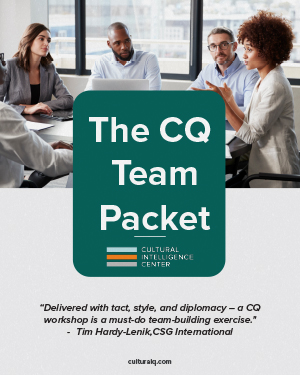Admit it. You like some cultures more than others.
• Headscarves—Yes or No?
• Senior Citizens—Out of Touch or Insightful?
• Southern Accent—Annoying or Charming?
It might not be these differences. But we all have implicit assumptions about certain cultures. And those preferences profoundly influence our thoughts, decisions, and behaviors. We’re all biased. And we need bias to survive. It’s the way our brains are wired to alert us to danger. But whether we act upon a bias is another thing altogether.
Unconscious bias training is all the rage these days. Left unchecked, unconscious biases are detrimental to leading effectively in the 21st Century—whether it’s hiring, marketing, or strategic planning. So companies, governments, and universities are investing millions of dollars in teaching staff about the implicit preferences they have for certain groups of people. In 2013, more than 13,000 of Google’s 46,000 employees attended unconscious bias training to expose staff to ways they unwittingly favor certain types of people based upon their upbringing, experiences, and values. Dow Chemical, Pricewaterhouse Coopers, and Novartis are also seeing this as one of the most important ways to equip their increasingly diverse workforces; and governments and military forces have jumped on the bandwagon too. A great deal of our work at the Cultural Intelligence Center is working with these kinds of organizations to integrate unconscious bias training with building a more culturally intelligent and inclusive organization.
Awareness of one’s own culture and the potential biases one may have toward others is the first step toward improving your effectiveness with diverse colleagues and customers. But it’s not enough. Awareness doesn’t automatically lead to cross-border results. The inevitable question after unconscious bias training is “Now what? I know I’m biased and so is everyone else. So what am I supposed to do about it?”
I’m a huge supporter of training people about unconscious bias. But it can’t stop there. You have to develop cultural intelligence to move from awareness to intercultural effectiveness. Here are a few ways to do so:
1. Identify your blind spots
If you haven’t been exposed to the groundbreaking work on unconscious bias, start there. Take one of the tests at Project Implicit and consider which groups of people you find most difficult to trust. How might that difficultly connect to a deeply rooted bias? Don’t be too quick to answer. And read Blindspot by Mahzarin Banaji and Anthony Greenwald, the best book I’ve read on this fascinating subject.
2. Train yourself to think differently
Simply becoming aware of a bias reduces its power to shape our decisions. The conscious side of the brain is very capable of doing the necessary work to train our minds to think differently. Look for where the bias emerges in your thinking and decision-making. Stop yourself when resorting to an unchecked assumption and choose to think differently. And use the power of repetition to regularly remind you of your otherwise overlooked biases.
3. Create practices to prevent bias
CQ Strategy, one of the four capabilities consistently found in those who are culturally intelligent, includes intentional planning in light of cultural differences. This includes developing strategies that account for your default preferences. Have names removed from resumes so you can initially screen candidates without knowing their gender or ethnicity. And tap the power of a diverse team to assess people more holistically. For example, if you have a bent toward hiring outgoing people and overlooking their work experience, involve a co-worker who has more bent toward hiring people based upon their skills and experience. And together, determine the best candidate.
4. Beware your gut
Many point to the gut as a shockingly reliable mechanism for decision-making. And it can be. Our subconscious has been programmed over time and when assessing a familiar situation, the gut often leads to a better result than spending hours reviewing pros and cons. But when the decision involves people and situations from different cultural backgrounds, it’s dangerous to rely upon your gut. Draw upon research-based findings about tendencies among certain cultural groups. Consult with others and consciously suspend trusting your gut. We don’t know yet what happened in the Ferguson, Missouri case that led to a police officer shooting a minor last month. But it’s worth asking how the “gut” guided everyone’s behavior.
5. Develop your CQ™
For organizations that have done very little training on diversity or working cross-culturally, start with cultural awareness. The kinds of things highlighted through unconscious bias training or through assessments that measure ethnocentrism or cultural orientations can be an ideal way to get at this. But once you’ve built awareness, discover which intercultural skills need the most attention.
Developing the skills to work effectively across cultures has always been the focus of our work. We’re working with organizations around the world to provide an integrated training plan that starts with unconscious bias, moves toward cultural intelligence training, and leads toward building an inclusive, culturally intelligent organization.
Cultural intelligence is not simply a new label for cultural sensitivity or cultural competence. It’s a form of intelligence that is proven to correlate with how effectively you work and relate across cultures. Assess your development in the four CQ capabilities—CQ Drive, CQ Knowledge, CQ Strategy, and CQ Action—and develop an action plan for addressing the areas that need the most improvement.
Intercultural conflicts and discrimination are rarely deliberate choices that are maliciously intended. They simply creep into everyday decisions. But as you account for your implicit biases and develop a plan for improving your CQ, you’ll find you can navigate through most any cultural situation with both respect and effectiveness.
